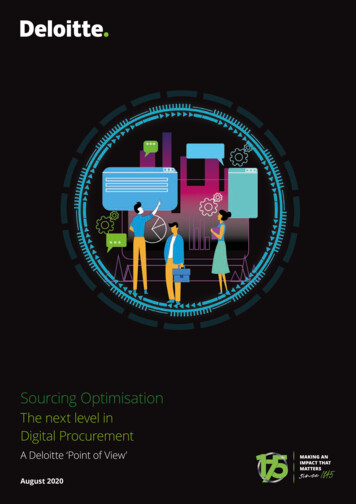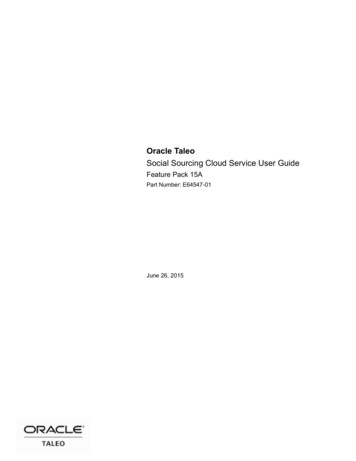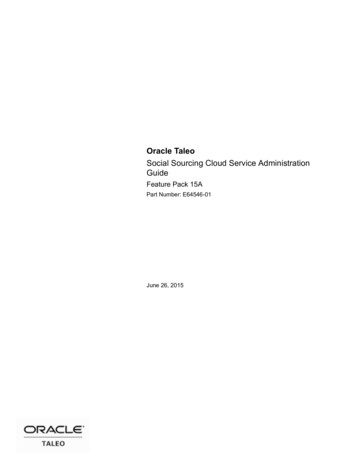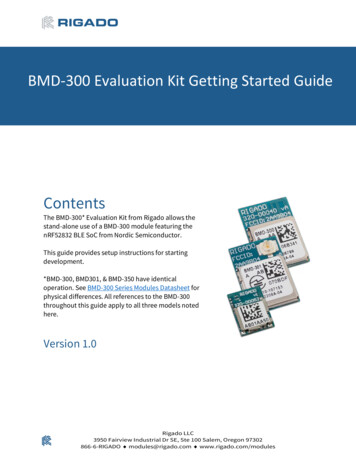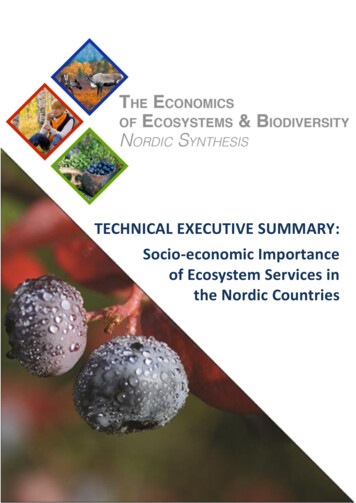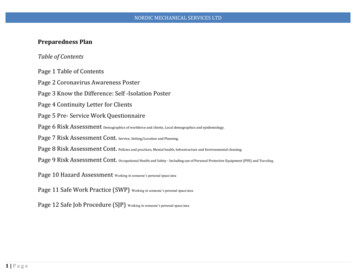
Transcription
Nordic IT sourcing& cloud survey2020Status and trends in the Nordic ITsourcing market
ContentsPage01 Executive summary302 Introduction4-803 Status per service tower9–3004 Looking ahead31–4005 About the survey41–422 Nordic IT Sourcing & Cloud Survey 2020
02Executive SummaryKey findings: Focusing on core business, improving flexibility and scalability are the overall key business drivers forIT outsourcing in the Nordics. Access to specific knowledge, expertise and tools are the most importantdrivers for application development/maintenance services. The survey results indicate that outsourcing will increase in the future in all service towers. Thisconfirms the trend towards more outsourcing from last year’s Norwegian IT outsourcing survey.Some organizations do, however indicate reduced outsourcing of their Application Development andMaintenance services. The survey results also show that while proactivity, innovation and continuous improvements areimportant expectations of the service providers, few service providers are delivering on this valueproposition. This could pave the way for new performance measurements in the outsourcing agreementsand more partner-led outsourcing, i.e. vested sourcing.Key EY Insights: Focus on drivers and benefits realization: Clearly define your purpose with outsourcing and the desiredbenefits (drivers) for your sourcing process. Focus on realizing benefits throughout your sourcing process(from strategy, through procurement and negotiations, to implementation and steady state). Consider the impact of key trends within the different service towers on your organization: Considercloud computing for your infrastructure services. Think personalization and user-centricity for yourDigital Workplace services. Evaluate data-driven, automated Service Desk solutions. Define a pace-layered model for your application portfolio: Use different models for your “run”,“differentiate” and “innovate” applications. Use managed services, where appropriate. Don’t underestimate the need to clearly articulate and possibly strengthen your retained organization: Toa large extent, success from outsourcing will depend on your own (retained) capabilities.3 Nordic IT Sourcing & Cloud Survey 2020
03Introduction4 Survey20202020
IntroductionDefinitionsThe purpose of this report is to identify and analyze trends inthe Nordic IT outsourcing market, and is based on a surveydistributed to 500 IT executives in large-scale private andpublic Nordic organizations. The survey addresses four mainservice towers, namely IT infrastructure, Digital Workplace,Service Desk and Application Development and Maintenance.The report also addresses cloud services in conjunction withIT infrastructure services. Below you will find correspondingdefinitions for each respective service tower, as used in thesurvey.IT Infrastructure:All services necessary to host applications, including data center, hardware and server software(virtualization, operating systems, middleware and runtime). IT infrastructure can comprise traditionalon premise hosting, private and public cloud.Digital workplace:Services used to deploy, manage and secure devices, applications and data that workers require toperform their jobs. It is often also referred to as end-user services.Service Desk:A service desk is a help desk that is equipped with the resources for resolving incidents, problemsand service requests. It gives the customer service representative or end user the ability to efficientlydiagnose, troubleshoot and correct technical-support problems, rather than being a “pass through”.Application Development and Maintenance:Application Development comprises all services that are necessary to create, change or removefunctionality. Application Maintenance comprises all services that are necessary to ensure the qualityof the application is maintained over time and is in accordance with the agreed service levels.5 Nordic IT Sourcing & Cloud Survey 2020
IntroductionThe degree of IT outsourcingIn general, the degree of outsourcing isquite high for all service towers. Acrossall service towers, at least two-fifthsof the respondents report that 60% ormore of their services are outsourced.IT Infrastructure services haveevolved to become a commodity,which most organizationshave outsourced. Most of therespondents have either outsourcedor let their Service Desk remaininhouse; very few have partiallyoutsourced this service. For the restof the Services Towers, the pictureis mixed.IT Infrastructure is the most outsourcedservice tower, with nearly half of therespondents reporting that 80%-100% oftheir infrastructure is outsourced.Application Development andMaintenance outsourcing have the mosteven distribution. One reason could bethe number of different applicationswhere commodity applications are easierto outsource than business-critical orsector-specific applications.Service Desk stands out, as two-fifthsof the respondents report that theirService Desk is fully retained inhouse.Partial outsourcing is less common forService Desk services than for the otherservice towers.IT InfrastructureService DeskDigital WorkplaceApplication Development and Maintenance01-19%620-39%40-59%60-79% Nordic IT Sourcing & Cloud Survey 202080-100
IntroductionThe key business drivers for IT outsourcingThe business drivers for“Infrastructure and OperationalServices” are mostly similar,while there is a significantdifference compared to ApplicationDevelopment and Maintenanceservices. “Focus on core business”,“Improve scalability” and “Improveflexibility” are reported as keybusiness drivers for all servicetowers. “Cost reduction” and“Access to specific knowledgeand expertise” are becomingincreasingly prominent.“Focus on Core business”, is amongthe top three drivers for all the“Infrastructure and OperationServices”¹. These are fundamentalservices supporting the business butdoes not drive the business.“Cost reduction” and “Costtransparency” are important drivers forall service towers, but most importantfor infrastructure services withalmost two-thirds of the respondentshighlighting these drivers.“Improve flexibility” and “Improvescalability” are important for all servicetowers, mostly for IT Infrastructure, butall service towers include them in thetop five business drivers for outsourcing.It’s worth noting that compared to the2019 EY Norwegian IT Outsourcingsurvey there is a notable increase inreported importance for “Improvescalability”. Scalability is fundamentalin cloud services, which indicates thatIT Infrastructure outsourcing is movingto IaaS (Infrastructure-as-a-Service),and Application Development andMaintenance outsourcing is movingto PaaS (Platform-as-a-Service) andSoftware-as-a-Service (SaaS).The respondents reported that, ingeneral, “Drive business transformation”and “Drive Innovation” are amongthe least important drivers for IToutsourcing.Application Development and MaintenancePercentage (%) of respondents reporting the business driver56%53%Improve scalability50%Drive business transformation47%Drive innovation44%Focus on core business44%Reduce time-to-market with new digital solutions36%Improvement of service quality36%Increased cost transparency31%Cost reduction25%¹ Consist of IT Infrastructure, Service Desk and Digital Workplace7 Nordic IT Sourcing & Cloud Survey 2020
IntroductionThe key business drivers for IT outsourcingInfrastructure and Operation ServicesDigital workplacePercentage (%) of respondents reporting the business driverFocus on core business69%50%Cost reduction42%Improve scalability36%33%Increased cost transparency31%Improvement of service quality31%Drive business transformation28%Reduce time-to-market with new digital solutions19%Drive innovation19%Service deskPercentage (%) of respondents reportingthe business driverFocus on core business44%Improve scalability42%42%Cost reduction39%Increased cost transparency25%Improvement of service quality25%14%Drive innovation 6%Drive business transformation 6%Reduce time-to-market with new digital solutions 3%IT InfrastructurePercentage (%) of respondents reporting the business driverImprove scalability81%81%Focus on core business75%Cost reduction67%Increased cost transparency64%Improvement of service quality61%Reduce time-to-market with new digital solutions39%39%Drive business transformationDrive innovation833%25% Nordic IT Sourcing & Cloud Survey 2020
03Status per service towerIT infrastructure, Digital Workplace, Service Desk and Application Development9 Nordic IT Sourcing & Cloud Survey 2020
IT InfrastructureStatus per service towerIT Infrastructure services summary andconsiderationsIT Infrastructure services are heavily outsourced, and all respondents are usingcloud services to some degree. Public cloud is gaining traction and is reported asmore commonly used than private cloud. IT Infrastructure outsourcing is drivenby need for scalability, flexibility and focus on core business which supports thetransition into cloud services.IT Infrastructure outsourcing provides benefits across the board, on all surveyedparameters and the respondents are mostly satisfied with their primary ITInfrastructure service providers.EY Insights:Some considerations whenoutsourcing IT Infrastructure servicesFocus on drivers andbenefits realizationClearly define the desired benefits(drivers) for your sourcing processand focus on realizing these benefitsthroughout your sourcing process (fromstrategy, through procurement andnegotiations, to implementation andsteady state). Create a business case toguide decisions.Consider cloud computingCloud-based delivery models must beconsidered as part of any sourcingprocess for IT Infrastructure services.We highly recommend conducting acloud-readiness assessment of your ITInfrastructure and application portfolio.The assessment should focus on bothbusiness value, technical feasibility andrisk. The cloud-readiness assessmentwill provide a solid information basisfor determining your cloud strategy,optimal future delivery model, andfor developing a transition andtransformation plan. Keep in mind thata simple “lift-and-shift” approach doesnot necessarily unlock all the benefits ofcloud computing. The cloud-readinessassessment should group applicationsaccording to the most beneficialmigration pattern (6R analysis).Furthermore, a transition to cloud takestime – plan for ensuring stable and costeffective operations during the transitionand apply traditional IT operationalrisk reduction principles for ensuringbusiness continuity.Think bi-modalThink bi-modal and bridge the gapbetween traditional IT and DevelopmentOperations (DevOps) by establishinga holistic IT Infrastructure operatingmodel covering both the models.We recommend establishing a cloudcenter of excellence combiningcloud competencies (e.g., fromDevOps teams) and traditionalinfrastructure competencies. Both sets10 Nordic IT Sourcing & Cloud Survey 2020of competencies are crucial in cloudtransformations as well as in steadystate. Furthermore, consider which tasksyou want to handle yourself and whichones you want to use external providersfor. Include traditional IT operationalrisk reduction approach and businesscontinuity into your IT operating model,cloud center of excellence setup andtransition and transformation plan.
IT InfrastructureStatus and drivers for IT InfrastructureoutsourcingWith two-thirds of the respondentsreporting that 60-100% of theirinfrastructure is outsourced, it indicatesthat IT Infrastructure services haveevolved to become a commodity.Compared to the 2019 EY NorwegianIT Outsourcing survey, the averageoutsourcing level has increased.The survey also shows that allrespondents are utilizing cloud to somedegree, as none report 100% use ofon-premise infrastructure. The surveyshows that SaaS is the most popularcloud-based delivery model.Degree of IT Infrastructure outsourcingPercentage (%) of respondents within each range10%IT Infrastructure services areheavily outsourced and allrespondents are using cloudservices to some degree. Publiccloud is gaining traction and isreported as more commonly usedthan private cloud.11%49%8%3%19%01-19%20-39%40-59%60-79%11 Nordic IT Sourcing & Cloud Survey 202080-100
IT InfrastructureStatus and drivers for IT Infrastructure outsourcingIT Infrastructure outsourcing is driven by need for scalability, flexibility and focus on the core business. This also supports thetransition to cloud-based services.“Improve scalability” and “Improveflexibility” are the most importantbusiness drivers for outsourcing of ITInfrastructure services. These driverscoincide well with the expected benefitsof cloud computing. As expected, thisindicates that the respondents arelooking towards the cloud for their ITInfrastructure services. It is, however,worth noticing that, contrary to thepromises of many cloud providers, therespondents do not expect outsourcingof IT Infrastructure services to driveinnovation or business transformation,as both are ranked as the two leastimportant drivers.Cost reduction is still an importantdriver for outsourcing IT Infrastructureservices. Approximately, two-thirdsof the respondents have pointed out“Cost reduction” and “Increased costtransparency” as important driversfor outsourcing their IT infrastructureservices.Compared to the 2019 EY Norwegian ITOutsourcing survey, the business drivers“Improve scalability” and “Improveflexibility” have increased significantly.“Focus on core business” continuesto be an important business driver foroutsourcing IT Infrastructure services.This underlines the potential impact ofcloud computing in the market for ITinfrastructure services.Top business drivers for IT Infrastructure ServicesPercentage (%) of respondents reporting the business driverImprove scalability81%81%Focus on core business75%Cost reduction67%Increased cost transparency64%Improvement of service quality61%Reduce time-to-market with new digital solutions39%39%Drive business transformationDrive innovation33%25%12 Nordic IT Sourcing & Cloud Survey 2020
IT InfrastructureBenefits and service providersatisfactionOutsourcing IT Infrastructureservices provides benefits acrossthe board. IT Infrastructureservices are mature, and the risksof outsourcing IT Infrastructureservices is relatively low versus thebenefits.for their IT Infrastructure outsourcinginitiatives.The survey shows that most of therespondents have achieved positiveresults across most parameters asa result of their current outsourcingagreement for IT Infrastructure services.The two exceptions are “Businesstransformation” and “Innovation”, wherethe majority report no change. This isas expected, since these parameters arealso reported as the two least importantbusiness drivers.The findings suggest that regardless ofthe emergence of new delivery modelsand rapid technological evolution, ITInfrastructure services are very matureand that outsourcing can be expected toyield significant benefits.Very few respondents reportnegative effects from outsourcing ITInfrastructure services and the positiveexperiences outweigh the ‘negativeon all parameters’ responses. Thisindicates that the risk of outsourcing ITInfrastructure services is relatively lowversus the benefits.The effect on the top three businessdrivers “Scalability”, “Flexibility” and“Focus on core business” has been verypositive across the board. This showsthat majority of the respondents haveachieved their most important goalsPercentage (%) of respondents within each range spliton outcomeScalabilityCost transparency81%16%3%79%18%3%Focus on core business70%Flexibility70%Cost levelInnovation21%33%41%44%Business 7%Time-to-market with new digital solutions0%30%61%Service quality7%20%73%Unchanged13 Nordic IT Sourcing & Cloud Survey 2020Worse26%
IT InfrastructureBenefits and service provider satisfactionThe respondents are mostly satisfied with their primary IT Infrastructure service providers.Almost half of the respondents reportthat they are satisfied with their primaryIT Infrastructure service provider.Approximately one-fifth report that theyare unsatisfied.Degree of satisfaction with primary service providerfor IT Infrastructure ServicesPercentage (%) of respondents reporting the degree of satisfactionA higher number of respondents reportthat they are unsatisfied with theirservice provider, compared to thosereporting a negative effects on the mostimportant drivers for outsourcing ITInfrastructure services. This indicatesthat the satisfaction with one’s serviceprovider can be low, even though theexpected benefits are achieved.21%48%31%Neutral14 Nordic IT Sourcing & Cloud Survey 2020
Service DeskService Desk services summary andconsiderationsPartial outsourcing is less common for Service Desk services than for the otherservice towers. Service Desk services have the highest degree of in-housedelivery among all service towers, with more than two-fifths reporting that theirService Desk is fully retained in-house.By outsourcing their Service Desk services, the respondents mainly aim forscalable and flexible services at a low cost to allow them to focus more on theircore business. Overall, the respondents report positive or unchanged effectson most parameters from outsourcing their Service Desk services. OutsourcingService Desk services has resulted in scalable and flexible services with highquality at a lower cost.Most respondents are satisfied with their Service Desk service providers and thesatisfaction rate is the highest of all service towers.EY Insights:Some considerations whenoutsourcing Service Desk servicesStart with a holistic view of the ServiceDesk services: The Service Desk should be the singlepoint of contact (SPOC) for all ITrelated inquiries. The Service Deskmanages the interaction between theusers, internal resources and externalparties. The service desk should: Articulate a target state withclear interfaces between the userand internal and external serviceproviders Focus on standardization andstreamlining both the userexperience and processesConsider the impact of key trendswithin the Service Desk area on yourorganization:Other important elements to considerwhen deciding on a future Service Desksetup: Personalized self-service solutions ondifferent platforms: Use of artificialintelligence (AI), chatbots, etc. Multi-channel and digital experience:Use more channels such as phone,email, chat and self-service. Insight/business intelligence/big data:Deeper insight into the performanceof your service desk and fact-baseddecision making. Digital hubs/dashboards: For fulloverview over all IT services. Cognitive automation: More effectivecase handling and incident resolution. Proactive identification and solutionfor incidents: Automatic monitoringand reporting of incidents withconnected sensors (Internet of Things(IoT)). Create a business case to guidedecisions15 Nordic IT Sourcing & Cloud Survey 2020 Proactivity and knowledge databases:Good overview of all reportedincidents and problems and relevantService Level Agreements (SLAs) tofacilitate proactivity and knowledgedatabases to facilitate self-service.
Service DeskService Desk services summary and considerationsService Desk services have thehighest degree of in-house deliveryamong all service towers withmore than 40% reporting that theirService Desks are fully retainedin-house.Partial outsourcing is less common forService Desk than for other servicetowers. This could stem from the ITteam’s inclination to retain control ofthe end-user interface by handling usersupport themselves.Note that less than one-fifth reportoutsourcing degree between 1%-79%,indicating that partial outsourcing ismuch less common for Service Deskservices than for the other servicetowers.On the other hand, more than two-fifthsof the respondents report that most( 80%) of their Service Desk services areoutsourced.Degree of Service Desk outsourcingPercentage (%) of respondents within each range41%43%5%01-19%3%20-39%8%40-59%60-79%16 Nordic IT Sourcing & Cloud Survey 202080-100%
Service DeskService Desk services summary and considerationsBy outsourcing their Service Desk services, the respondents mainly aim for scalable and flexible services at a low cost to allowthem to focus more on their core business.The main business drivers foroutsourcing Service Desk services areto “Focus on core business” , “Improvescalability” and “Improve flexibility”,closely followed by “Cost reduction”.different time zones. For smaller andlocal organizations, it is a solution tosupport the demand for 365x24x7support.For global organizations, outsourcingthe Service Desk seems to be a solutionfor supporting different countries intransformation” and “Innovation”,something that is to be expected.The least reported reasons foroutsourcing Service Desk servicesare “Reduce time-to-market with newdigital solutions”, “Drive businessTop business drivers for outsourcing Service Desk ServicesPercentage (%) of respondents reporting the business driverFocus on core business44%Improve scalability42%42%Cost reduction39%Increased cost transparency25%Improvement of service quality25%14%Drive innovation6%Drive business transformation6%Reduce time-to-market with new digital solutions3%17 Nordic IT Sourcing & Cloud Survey 2020
Service DeskBenefits and service providersatisfactionOverall, the respondents report positive or unchanged effects on most parameters from outsourcing their Service Deskservices. Outsourcing Service Desk services have resulted in a scalable and flexible Service Desk service with high quality, at alower cost.Nearly nine out of ten report a positiveeffect on “Scalability“, which refers tothe ability of the service provider toadjust the volume up and down.More than 60% of the respondentsreport that outsourcing their ServiceDesk services have affected “Costlevel” and “Cost transparency” in apositive way. Furthermore, most of therespondents report similar or improvedservice quality, indicating that thereduced cost has not had a negativeeffect on the service quality.More than two-thirds of respondentsreport no change on “Businesstransformation, “Time to market withnew digital solutions” and “Innovation”,which is to be expected based on thereported drivers.The only exception is “Innovation”where even though the majority reportno change, there is significantly morerespondents reporting worse resultsthan better.Percentage (%) of respondents within each rangesplit on outcomeScalability88%Cost level6% 6%65%Cost transparency18%63%Focus on core business25%59%Flexibility53%Service quality53%Time-to-market with new digital %22%7%12%29%38%Business transformation17%7%79%67%Unchanged7%26%Worse18 Nordic IT Sourcing & Cloud Survey 2020
Service DeskBenefits and service provider satisfactionAround two-thirds of the respondentsare satisfied with their service providerfor Service Desk services, while themajority of the remaining one-third areneutral.are unsatisfied, which indicates thehighest service provider satisfactionamong all service towers.Around one-tenth of the respondentswho have outsourced their Service DeskPercentage (%) of respondents reporting the degree of satisfactionMost respondents are satisfied withtheir Service Desk service providersand the satisfaction rate is thehighest among all service towers.12%24%65%Neutral19 Nordic IT Sourcing & Cloud Survey 2020
Digital WorkplaceDigital Workplace services summary andconsiderationsDigital Workplace services are quite heavily outsourced with two-fifths of therespondents reporting that more than 60% of their Digital Workplace services areoutsourced. Digital Workplace outsourcing is driven by focus on core business,and providing flexibility and scalability at a reasonable cost level. In general, therespondents report positive or unchanged results from outsourcing their DigitalWorkplace services. Most prominently, it has allowed them to focus on their corebusiness and provided more scalable service deliveries. The respondents are alsomostly satisfied with their Digital Workplace service providers.EY Insights:Some considerations whenoutsourcing Digital WorkplaceservicesStart with a user-centric focus: Articulate a clear target state with auser-centric focus (utilize user stories/use cases). Clearly define the interfacebetween hardware vendors, internal/external service providers, IT and theend user, and focus on standardizationand streamlining to enhance the userexperience. Also, clearly define usersupport processes and interfaces.Create a business case to guidedecisions.Consider the impact of key trendswithin Digital Workplace on yourorganization: Bring your own device (BYOD)/Chooseyour own device (CYOD): Rapidlyincreasing employee expectationsbased on their experience fromconsumer electronics (employees wanteasy access to work applications andresources on all devices, anywhere,anytime). Personalized and user-centricsupport: Proactive support based onemployees’ personal needs and workcontext. Legacy systems: Clearly define howlegacy hardware and software will behandled and supported. Consider useof virtualization. Digital hub: Digital Workplace thatworks as a seamless hub where theuser finds all their applications andservices by the use of cloud-basedsolutions. Rapid technological developmentwithin device management(management solutions deliveredas SaaS): Ensure that your vendoris contractually obligated to followmarket development and innovatetheir services. Also, focus on benefitsrealization. Automation: Implementation andautomation of setup, configurationand management, and possibilities forno-hands setup and pre-configurationusing tools such as Autopilot andIntune.Other important elements to considerwhen deciding on a future DigitalWorkplace setup: Client-as-a-Service (CaaS) or endto-end device management: Theservice provider takes full life cycleresponsibility for managing all devicesused in the organization. Standardization: Standardizeddevices, operating systems (OS)and applications make automation,streamlining and “shift-left” easier.20 Nordic IT Sourcing & Cloud Survey 2020 User satisfaction — a key KPI: Considerincluding it as a SLA parameter in thecontract with the service provider.
Digital WorkplaceStatus and drivers for Digital WorkplaceoutsourcingTwo-fifths of the respondents report thatmore than 60% of their Digital Workplaceservices are outsourced. Workstations and laptop equipment Cloud services for office applicationsand video conferencingSurprisingly, almost one-fifth ofthe respondents still have all DigitalWorkplace services inhouse. The spreadin the degree of outsourcing shows thatsome choose to outsource parts of thedigital workplace services, such as: Mobile devices, i.e. smartphones andtabletsDegree of Digital Workplace outsourcingPercentage (%) of respondents within each rangeDigital Workplace is quiteheavily outsourced, but manyorganizations choose to outsourceonly parts of the Digital 9%60-79%21 Nordic IT Sourcing & Cloud Survey 202080-100%
Digital WorkplaceStatus and drivers for Digital Workplace outsourcingDigital Workplace outsourcing is driven by focus on the core business and providing flexibility and scalability at a reasonablecost level.“Focus on core business“ is by far themost commonly reported businessdriver for outsourcing Digital Workplaceservices. “Improve flexibility” and“Improve scalability”, together with“Cost reduction”, are also among thetop four business drivers for outsourcingDigital Workplace services.Digital Workplace services encompassservices used to deploy, manage andsecure the devices, applications and datathat employees require to perform theirjobs. Thus, this service is aimed at theinternal workforce rather than externalcustomers. Therefore, it is natural that“Reduced time to market with newdigital solutions” and “Drive innovation”are rated as less important businessdrivers.Top business drivers for Digital Workplace ServicesPercentage (%) of respondents reporting the business driverFocus on core business69%50%Cost reduction42%Improve scalability36%33%Increased cost transparency31%Improvement of service quality31%Drive business transformationReduce time-to-market with new digital solutionsDrive innovation28%19%19%22 Nordic IT Sourcing & Cloud Survey 2020
Digital WorkplaceBenefits and service providersatisfactionIn general, the respondents report positive or unchanged results from outsourcing their Digital Workplace services. Mostprominently, it has allowed them to focus on their core business and provided a more scalable service delivery.Generally, respondents report that IT outsourcing initiativesfor Digital Workplace services have largely contributed topositive benefits. “Focus on core business” and “Scalability”are reported as the parameters which have been mostpositively influenced by outsourcing Digital Workplaceservices.23 Nordic IT Sourcing & Cloud Survey 2020
Digital WorkplaceBenefits and service provider satisfactionFurthermore, the majority of therespondents also report positive effectson both “Service quality”, “Flexibility”and “Access to specific knowledge,expertise and tools”.On the other hand, outsourcing DigitalWorkplace services has had a lowimpact on several other parameters. Forinstance, around 60% report no changeon “Business transformation”, “Time-tomarket with new digital solutions” and“Innovation”. This is however very muchas expected, as these were reportedas the three least important drivers foroutsourcing Digital workplace services.An interesting observation is that whilecost reduction was reported as thethird most important driver, nearly halfreport no change, indicating that theirexpectations for this parameter have notbeen met.experiences outweigh the
the Nordic IT outsourcing market, and is based on a survey distributed to 500 IT executives in large-scale private and public Nordic organizations. The survey addresses four main . Services used to deploy, manage and secure devices, applications and data that workers require to perform their jobs. It is often also referred to as end-user .


